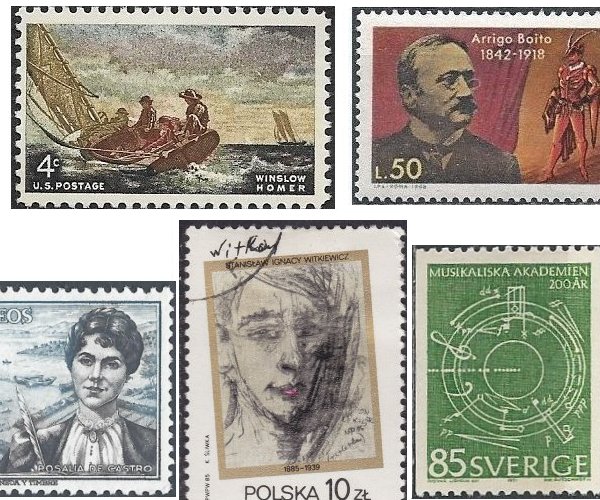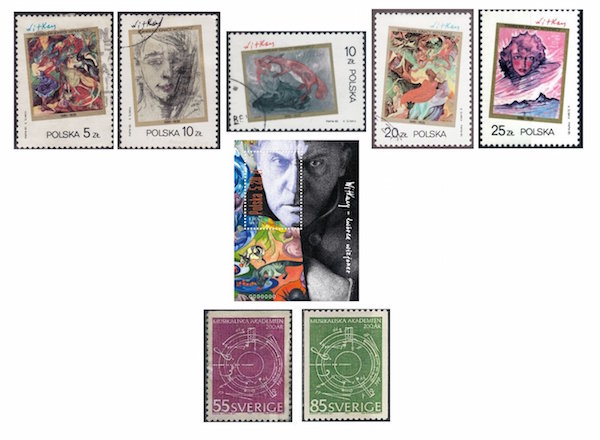The Arts on the Stamps of the World — February 24
An Arts Fuse regular feature: the arts on stamps of the world.

By Doug Briscoe
February 24 is the birthday of Winslow Homer and Arrigo Boito as well as of the painters Charles Le Brun and J. C. Dahl, the writers Rosalía de Castro and Stanisław Witkiewicz (sta-NEE-swahf vit-K’YEH-vitch), and Swedish composer Ingvar Lidholm, who turns 96 today.
Three American stamps reproduce paintings by Winslow Homer (February 24, 1836 – September 29, 1910): Breezing Up (aka A Fair Wind; 1876), perhaps his best known work, on a 1962 issue; The Fog Warning (1885) on a 1998 stamp; and Boys in a Pasture (1874) issued in 2010 for the centenary of the artist’s death. The last two paintings are both at the MFA. The two youngsters in Boys in a Pasture were from Belmont and got paid 75 cents a day to pose.
Italian composer and libettist Arrigo Boito (1842 – 10 June 1918) was born Enrico Giuseppe Giovanni Boito in Padua to an Italian miniature painter and a Polish countess. He fought against the Austrians in the Seven Weeks War, was romantically involved with the actress Eleonora Duse and, as an atheist, is buried in a special section of the Cimitero Monumentale in Milan. Boito the composer left only a small body of music: his masterpiece, the opera Mefistofele (1868), a symphony in a minor, and the unfinished opera Nerone (Nero), which was completed by Toscanini and Vincenzo Tommasini and premièred at La Scala in 1924. Fine as Mefistofele is, Boito is likely more remembered for his libretti for Verdi’s Otello and Falstaff and Ponchielli’s La Gioconda. He had completed a third Shakespearean libretto for Verdi on King Lear but the project was never realized. (Another opera librettist, Carlo Goldoni, has a birthday tomorrow!)
Charles Le Brun (1619 – 22 February 1690) achieved considerable influence at the court of Louis XIV, who regarded him as “the greatest French artist of all time”. Paris born, Le Brun’s gifts were noted very early by no less a figure than the Chancellor of France, and at 11 he was apprenticed to the painter and draftsman Simon Vouet. He was already receiving commissions from Cardinal Richelieu (!) by the age of 15 (!) and deeply impressed Nicolas Poussin, with whom Le Brun traveled to Rome. Le Brun demonstrated that he not only had a genius for painting, but was clearly also a very clever fellow when it came to looking out for himself, for he earned the confidence of both Cardinal Mazarin and Comptroller-General Colbert. With the latter, Le Brun founded the Gobelins in 1660. Two years later, his Alexander and the Family of Darius so pleased the Sun King that the artist was instantly ennobled and went on to have direction of all artistic matters in the royal palaces. The two French stamps display his drawing “Kneeling Woman” and his 1642 portrait of Pierre Corneille.

Another painter who benefited from royal patronage was Johan Christian Dahl (1788 – 14 October 1857). Better known as J. C. Dahl, he is admired as a seminal figure in Norwegian painting, perhaps its foremost representative, as well as a great art promoter and preservationist. Yet he was a man who resented his humble origins as the son of a fisherman and always felt he could have accomplished more if he had had an earlier exposure to a sound education. As it was, his intelligence and then his artistic gifts were recognized by a local priest, and another supportive patron collected funds for Dahl to attend the academy in Copenhagen. In that city his landscapes caught the eye of the future King Christian VIII (then Prince Christian Frederik), with whom Dahl formed a lasting friendship. Traveling to Dresden a few years later, he developed a similar relationship with the German painter Caspar David Friedrich. Together with Carl Gustav Carus, they would have a decisive influence on German romantic nature painting. In 1820 Dahl’s friend the prince invited him to Naples, where Dahl remained nearly a year absorbing the culture and the light. Dahl was generous to young artists, took a keen interest in the the preservation and restoration of Norwegian stave churches and other old structures, and was one of the founders of the National Gallery of Norway (a fine collection, by the way). His life was soured, though, with the losses of both his young wives in childbirth and three of his small children, two of them to scarlet fever. The Norwegian stamp from 1974 gives us Dahl’s Stugunøset at Filefjell of 1851, which hangs in the National Gallery Dahl helped establish. You can better appreciate the beauty of the work here.
Greatly admired in her native Spain, the romanticist poet Rosalía de Castro (1837 – 15 July 1885) bucked tradition by composing her verses in the Galician tongue, at the time disdained by the elite as a vulgar dialect. Her importance in so doing is such that the date of publication of her first poetry collection, Cantares gallegos, is celebrated as an official holiday in Galicia. Día das Letras Galegas—Galician Literature Day—has been recognized every May 17 since 1963, the centennial of that publication. Beyond that, De Castro’s image used to be found on the 500 peseta banknote, and many institutions, parks, and other entities bear her name. Her poor health and financial difficulties are believed to have caused the pervasive melancholy (saudade) of her work, which also consists of much prose, but she was committed to defense of the poor, resistance to blind authority, and women’s rights. She died from uterine cancer at the age of 48.
Stanisław Witkiewicz (1885 – 18 September 1939) bore the same name as his father, a painter, architect, and art critic. The son became a painter, a playwright, and a novelist. Witkiewicz led what must be called an exciting life. Commissioned as an officer in the Russian Imperial army, he was a witness to Revolution while stationed in St Petersburg. He began painting portraits as a means of earning income and eventually established the S.I. Witkiewicz Portrait Painting Company, through which the customer could select the desired style from representational to expressionistic and even, specifically, drug-assisted. Witkiewicz even listed which particular drugs had been consumed during the creation of a given painting, even if it was only coffee. He experimented with narcotics regularly and wrote about it in his second novel, Insatiability (1930), and his manifesto Narcotics (1932), both works also exploring philosophy. Earlier he had concentrated on plays, writing about forty of them between 1918 and 1925. (About half of these are lost.) It was after the latter year that he began to use the name “Witkacy” and signing his work with a number of variants such as Witkatze, Vitkacius, and Vitecasse (French for “breaks quickly”). In 1935 the Polish Academy of Literature awarded him their Golden Laurel for his novels. He was close friends with the composer Karol Szymanowski and promoted new writers including Bruno Schulz. But the end of his life was tragic: he escaped the German invasion of Western Poland only to find that the Soviets had invaded the East, and he committed suicide with a drug overdose. In an ironic postcript that no doubt would have amused Witkiewicz himself, his remains were to be exhumed for reburial in Zakopane, and the Soviets delivered a coffin but insisted that it not be opened. In 1994 DNA tests showed that the body was that of an unknown woman. Poland issued a set of five stamps of his paintings, including a self-portrait, in his centennial year and a striking minisheet (not shown to scale) just two years ago.

Today is also the birthday of 96-year-old Swedish composer Ingvar Lidholm (b. 1921). This stamp is the first and only one in the world for which the musical score was expressly composed and reproduced. “Stamp Music” was written using a new form of notation in 1971 for a set of stamps marking the 200th anniversary of the Royal Swedish Academy of Music.
Wilhelm Carl Grimm (1786 – 16 December 1859) was the younger of the Brothers Grimm. Since we have already saluted big brother Jakob here just last month, and there is no stamp honoring Wilhelm independently, I leave the rest to silence.
Happy 85th birthday to Michel Legrand!
A graduate of the University of Massachusetts with a B.A. in English, Doug Briscoe worked in Boston classical music radio, at WCRB, WGBH, and WBUR, for about 25 years, beginning in 1977. He has the curious distinction of having succeeded Robert J. Lurtsema twice, first as host of WGBH’s weekday morning classical music program in 1993, then as host of the weekend program when Robert J.’s health failed in 2000. Doug also wrote liner notes for several of the late Gunther Schuller’s GM Recordings releases as well as program notes for the Boston Classical Orchestra. For the past few years he’s been posting a Facebook “blog” of classical music on stamps of the world, which has now been expanded to encompass all the arts for The Arts Fuse
